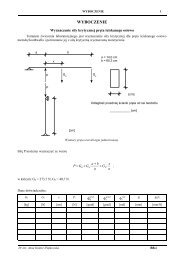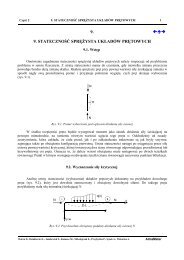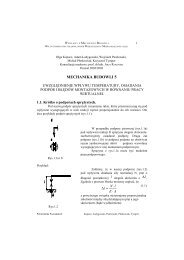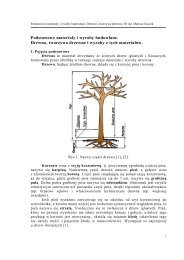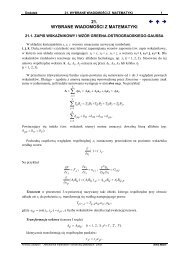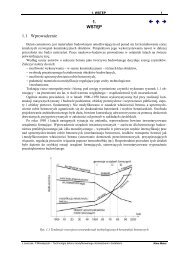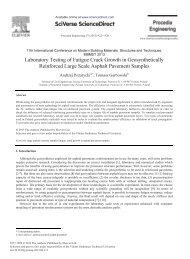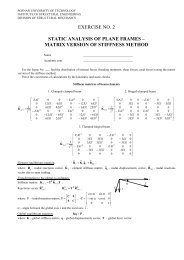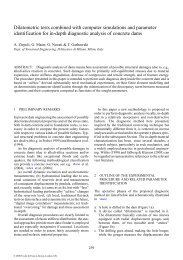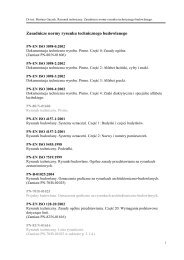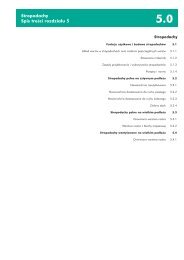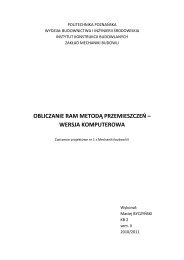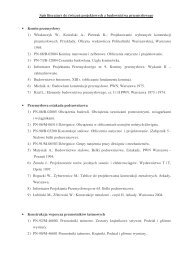SEARCHING PROCESS MODELING OF INTERNATIONAL - Poznań
SEARCHING PROCESS MODELING OF INTERNATIONAL - Poznań
SEARCHING PROCESS MODELING OF INTERNATIONAL - Poznań
You also want an ePaper? Increase the reach of your titles
YUMPU automatically turns print PDFs into web optimized ePapers that Google loves.
F O U N D A T I O N S O F C I V I L A N D E N V I R O N M E N T A L E N G I N E E R I N G<br />
No. 6 2005<br />
Arvydas JUODIS 1 , Ala SISKINA 2 , Povilas STALIORAITIS 3 ,<br />
1 Professor, Kaunas University of Technology,<br />
Studentu str. 48 – 415, Kaunas, Lithuania, e-mail: arvydas.juodis@ktu.lt<br />
2 PhD student, Kaunas University of Technology,<br />
Studentu str. 48 – 415,Kaunas, Lithuania, e-mail: ala.siskina@ktu.lt<br />
3 PhD student, Kaunas University of Technology,<br />
Studentu str. 48 – 415,Kaunas, Lithuania, e-mail: p.stalioraitis@stud.ktu.lt<br />
<strong>SEARCHING</strong> <strong>PROCESS</strong> <strong>MODELING</strong> <strong>OF</strong> <strong>INTERNATIONAL</strong><br />
CONSTRUCTION MARKET SEGMENTS<br />
The development of globalisation processes has influenced all the countries of the<br />
world and all areas of human activity. In terms of globalisation, there is increasing international<br />
cooperation between companies and development of construction markets become<br />
more rapid. This stimulates competition between contractors and forces them to<br />
review their operation strategies. Taking the decision upon entering markets abroad it is<br />
necessary to estimate and evaluate important factors and criteria.<br />
The problem issue of this work is as follows: how to choose the right market segment<br />
in construction industry?<br />
This paper presents a new methodology developed for implementation and execution<br />
of formalized market search and target segment identification process. The target<br />
markets are identified according to the multiple criteria decision-making methodology<br />
(Game theory and models for selection of the definite alternative solution based on the<br />
highest efficiency).<br />
The work was focused on the analysis of construction markets in 3 countries:<br />
Germany, Lithuania and Russia (Kaliningrad region), which differ in many demographic,<br />
economic and political terms. Such situation provides possibilities for more<br />
effective capacity utilization in construction industry. Choosing the right way of entering<br />
a host country market and selecting the target market segment benefits the company in<br />
financial and legal aspects.<br />
Key words: International construction, market segmentation, multiple criteria<br />
evaluation<br />
© Publishing House of Poznan University of Technology, Pozna� 2005<br />
ISSN 1642-9303
72<br />
1. INTRODUCTION<br />
Arvydas Juodis, Ala Siskina, Povilas Stalioraitis<br />
Construction activity is a complex process, including many participants,<br />
areas of information and engineering. With the development of globalization<br />
processes construction activities are becoming the subject of international economical<br />
relations (Juodis 2001, Fridlin 1996, Raftery et al. 1998, Bon and<br />
Crosthwaite 2000). Globalization phenomena provide new opportunities for<br />
construction companies to develop (Porter 1990). Contractors construct buildings<br />
not only in their own countries but in foreign countries as well. However,<br />
due to this phenomenon larger competition occurs on both national and global<br />
economical level. In some bigger European construction concerns construction<br />
in foreign countries make more than a half of the total construction works<br />
(Juodis 2001).<br />
In economically advanced countries constructions make 8 – 10 % of gross<br />
national product and the number of the employed makes approximately 4 – 9 %<br />
of all the working people in the national economy. Great number of construction<br />
are being carried out in the developing countries such as Asia, Africa, South<br />
America which is quite an attractive constructional market for the construction<br />
companies of the developed countries (Jaselskis and Talukhaba 1998). International<br />
construction projects in many cases are more profitable than the national<br />
ones as their value is much greater (Han and Diekmann 2001). In spite of the<br />
fact that export of construction activities bears more risk elements compared<br />
with activities on the national market (Hastak and Shaked 2000, Sloan and<br />
Weisberg 1997) the biggest construction concerns in the world penetrate into the<br />
markets of other countries. Aiming to decrease contractors’ risk related to construction<br />
activities outside his home-country, different calculations are made and<br />
major factors having influence on the final decision are evaluated. With regard to<br />
Lithuania, construction contractors do not have much experience in expanding<br />
their activities into new foreign markets (Juodis and Šiškina 2004). However,<br />
international construction performance have a developing tendency, thus a practical<br />
demand to evaluate potential decisions of export of constructional activity<br />
occurs.<br />
The aim of this paper is to present a model of construction markets and<br />
search process of their segments by applying a method of multiple criteria<br />
evaluation of alternative decisions.<br />
2. SEGMENTATION <strong>OF</strong> CONSTRUCTION MARKET<br />
In various countries different requirements for construction activities are<br />
raised. Contractors distinguish their weak and strong points and only then adopt
Searching process modeling… 73<br />
a decision whether to develop their activities in foreign countries or not (Ofori<br />
2003). On this basis market segmentation and risk analysis of future activities<br />
are performed (Alarcon and Bastias 2000).<br />
The schema of segmentation of construction market according to different<br />
criteria is shown in Fig. 1.<br />
CUSTOMER<br />
PUBLIC<br />
<strong>OF</strong>FICES<br />
COMPANIES<br />
NON-PR<strong>OF</strong>IT<br />
ORGANIZATIONS<br />
PRIVATE<br />
SECTOR<br />
SEGMENTATION <strong>OF</strong> CONSTRUCTION MARKET<br />
ECONOMY<br />
INDUSTRY<br />
AGRICULTURE<br />
SOCIAL AND<br />
CULTURE<br />
DWELLING<br />
INFRA-<br />
STRUCTURE<br />
WORK SPECIALIZATION<br />
<strong>OF</strong> CONTRACTOR<br />
EARTHWORK<br />
ENGINEER NETWORKS<br />
CONSTRUCTION<br />
WORKS<br />
FINISHING<br />
PLUMBING<br />
ELECTRIC WORKS<br />
TECHNOLOGICAL<br />
WORKS<br />
Fig. 1. The segmentation of construction market<br />
ORDER <strong>OF</strong><br />
WORKS<br />
NEW<br />
CONSTRUCTION<br />
MODERNIZATION<br />
RECONSTRUCTION<br />
RESTORATION<br />
THE PLACE <strong>OF</strong><br />
CONSTRUCTION<br />
FOREIGN COUNTRIES<br />
DISTRICT<br />
CITY<br />
The following major factors are evaluated most often:<br />
� course of coordination of a building project,<br />
� local/national regulations, rules and law acts;<br />
� climate/weather conditions;<br />
� geological/seismic conditions,<br />
� language of agreements and other documentation,<br />
� price and productivity of labour force,<br />
� if resources are required,<br />
� quality of construction material, conditions of their provision and period;<br />
� rent prices of mechanisms and equipment,<br />
� local traditions and festivals,
74<br />
Arvydas Juodis, Ala Siskina, Povilas Stalioraitis<br />
� local infrastructure;<br />
� local communications lines and access to them;<br />
� conditions of project financing and settlement for the works performed;<br />
� taxes, insurance etc;<br />
� attitude of state institutions towards the companies from other countries.<br />
3. ANALYSIS AND SELECTION <strong>OF</strong> CONSTRUCTION<br />
ALTERNATIVE MARKETS<br />
With the developing political and economical integration processes in<br />
Europe and in the whole world an opportunity for Lithuanian companies to notice<br />
and evaluate the differences, existing in the practical implementation of construction<br />
projects, has emerged. Therefore, a new developing trend – firm’s operating<br />
under contract in foreign countries, appeared for construction companies<br />
of Lithuania. It is a very important and multidirectional function of strategic<br />
development of management. Some construction companies of Lithuania have to<br />
deal with international performance issues of construction activities.<br />
For Lithuania potential market of constructional activities is the market of<br />
European Union countries as due to the developed relations they are close from<br />
the point of view of geography, climate, law and history. However, Lithuania is<br />
in such a geographical location that it has to evaluate the close market of Eastern<br />
countries. Firstly, it is a matter of Russia. Both constructional markets have advantages<br />
and disadvantages.<br />
Construction activities in western European countries are so far complicated<br />
for construction companies of Lithuania. A fierce competition prevails in<br />
this market as construction works of high quality and other aspects are characteristic.<br />
Contractors of Lithuania and other Baltic countries may offer lower prices,<br />
rapidly increasing labour productivity and quality.<br />
Lithuanian companies have many advantages in the construction market of<br />
Eastern countries, because they already have working practice, are well aware of<br />
the mentality and activity conditions in these countries. In the mentioned countries<br />
a lot of common constructional materials, mechanisms satisfying the requirements<br />
for quality, are used. Therefore, a problem is that the level of fulfillment<br />
of financial commitments is rather low. Thus, settlements for the works<br />
performed are usually made behind time.<br />
Block scheme of determination of a segment of optimal house-building<br />
market for a company is shown in Fig. 2.
Searching process modeling… 75<br />
THE PLACE <strong>OF</strong> CONSTRUCTION ECONOMY<br />
LITHUANIA<br />
GERMANY<br />
RUSSIA (KALININGRAD)<br />
DEFINDING THE GOAL<br />
INITIAL DATA COLLECTION<br />
INITIAL DATA <strong>PROCESS</strong>ING<br />
SEGMENTATION <strong>OF</strong> CONSTRUCTION MARKET (Fig. 1)<br />
GAME THEORY (SAVITCH‘S<br />
CRITERION)<br />
SELECTION <strong>OF</strong> OPTIMAL<br />
DECISION USING<br />
MULTIPLE CRITERIA<br />
EVALUATION METHOD<br />
APARTMENT HOUSES<br />
BRICK HOUSES<br />
WOODEN HOUSES<br />
FRAME HOUSES<br />
METHOD <strong>OF</strong> DETERMINATION<br />
PRIORITY <strong>OF</strong> ALTERNATIVES<br />
BASED ON THE CRITERION <strong>OF</strong><br />
PROXIMITY TO AN IDEAL POINT<br />
OPTIMAL CONSTRUCTION MARKET AND SEGMENT<br />
Fig. 2. The block scheme of definition of optimal construction’s market segment for the<br />
construction company<br />
Segmentation of construction markets was performed according to the following<br />
two factors: geographical location and type of construction (Fig. 1). According<br />
to the geographical location 3 market segments were distinguished: construction<br />
market in Lithuania (R1), Germany (R2) and Russia (Kaliningrad region)<br />
(R3); according to the type of construction 4 segments are distinguished:<br />
apartment houses (S1, S5, S9), one-family brick houses (S2, S6, S10), one-family
76<br />
Arvydas Juodis, Ala Siskina, Povilas Stalioraitis<br />
wooden houses (S3, S7, S11) and one-family frame houses (S4, S8, S12). Segments<br />
of alternative construction markets of the house-building are shown in Fig. 3.<br />
1<br />
R1<br />
R3<br />
R2<br />
2<br />
4<br />
S1<br />
3<br />
S12<br />
5 6<br />
S2<br />
Fig. 3. Structuring housing markets<br />
In Fig. 3 the following marking signs are used: R – alternatives of international<br />
construction markets, S – segments of international construction markets<br />
(Table 1).<br />
Table 1. Structuring international housing markets<br />
Notation Alternatives of construction’s markets segments<br />
S1 Apartment houses in Lithuania’s construction market<br />
S2 One-family brick houses in Lithuania’s construction market<br />
S3 One-family wooden houses in Lithuania’s construction market<br />
S4 One-family frame houses in Lithuania’s construction market<br />
S5 Apartment houses in Germany’s construction market<br />
S6 One-family brick houses in Germany’s construction market<br />
S7 One-family wooden houses in Germany’s construction market<br />
S8 One-family frame houses in Germany’s construction market<br />
S9 Apartment houses in Russia (Kaliningrad) construction market<br />
S10 One-family brick houses in Russia (Kaliningrad) construction market<br />
S11 One-family wooden houses in Russia (Kaliningrad) construction market<br />
S12 One-family frame houses in Russia (Kaliningrad) construction market<br />
S11<br />
S3<br />
S4<br />
S9<br />
S10<br />
16<br />
S5<br />
S8<br />
15<br />
7<br />
8<br />
S6<br />
S7<br />
14<br />
13<br />
9<br />
12<br />
10<br />
11
Searching process modeling… 77<br />
4. EVALUATION <strong>OF</strong> SEGMENTS <strong>OF</strong> CONSTRUCTION<br />
MARKETS<br />
Methodology of neural network systems (Parvar et al. 2000, Dikmen<br />
2001, Dikmen and Birgonul 2004) is used for analysis of international construction<br />
markets and preparation of decisions. In this paper performed optimal discovery<br />
of construction market segment applying a method of multiple criteria<br />
evaluation. This method is also employed in dealing with other construction<br />
tasks (Zavadskas et al. 1996). Initial data are provided in Table 2. They are received<br />
from calculations or experts’ survey.<br />
4.1. Selection of optimal market by applying Game theory according<br />
to Savitch’s criterion<br />
The theory of a game is a special class of mathematical models for making<br />
decisions under specific circumstances (Zavadskas et al. 1996). Selected alternative<br />
in such a way leads to the most effective solution to be made. By applying<br />
Game theory, effectiveness of the project under implementation depends on the<br />
specialist’s, who makes decisions, chosen strategy. In Game theory chosen alternatives<br />
(variants) are analysed as strategies of a specialist who makes decisions<br />
(Zavadskas et al. 1996).<br />
In Table 2 alternatives of house-building market segments Ai and the criteria<br />
of their evaluation Kj. are presented.<br />
While searching for proper construction market segment different evaluation<br />
criteria are used (Dikmen and Birgonul 2004). In this case six criteria were<br />
chosen: K1, K2, K3, K4, K6 whereof belong to the group of technical and economical<br />
index. Special measurement units characterize them. Criteria K5 is an<br />
index, which has no dimension, thus scores characterize it.<br />
Normalization of initial matrix data is performed according to the methods<br />
of scale transformation. Optimal variant is calculated according to Savitch’s<br />
criterion, the aim of which is to minimize losses. Mathematical expression of<br />
Savitch’s criterion is provided in the following formula (4.1) (Zavadskas et al.<br />
1996):
A 1<br />
A2<br />
A3<br />
A4<br />
A5<br />
A6<br />
A7<br />
A8<br />
A9<br />
A10<br />
A11<br />
A12<br />
Alternatives<br />
Lithuania’s market: Apartment houses<br />
Lithuania’s market: Brick houses<br />
Lithuania’s market: Wooden houses<br />
Lithuania’s market: Frame houses<br />
Germany’s market: Apartment houses<br />
Germany’s market: Brick houses<br />
Germany’s market: Wooden houses<br />
Germany’s market: Fame houses<br />
Russian (Kaliningrad) market: Apartment houses<br />
Russian (Kaliningrad) market: Brick houses<br />
Russian (Kaliningrad) market: Wooden houses<br />
Russian (Kaliningrad) market: Frame houses<br />
Table 2. Primary data of alternatives according to various criteria<br />
Average<br />
price of<br />
construction,<br />
€/m 2<br />
K1<br />
695<br />
521<br />
348<br />
434<br />
904<br />
678<br />
452<br />
565<br />
487<br />
365<br />
243<br />
304<br />
Average<br />
price of<br />
work<br />
force,<br />
€/h<br />
K2<br />
1.64<br />
1.64<br />
1.64<br />
1.64<br />
13<br />
13<br />
13<br />
13<br />
1.15<br />
1.15<br />
1.15<br />
1.15<br />
Average<br />
price of<br />
mechanisms,<br />
€/h<br />
K3<br />
14.25<br />
14.25<br />
14.25<br />
14.25<br />
112.5<br />
112.5<br />
112.5<br />
112.5<br />
10.7<br />
10.7<br />
10.7<br />
10.7<br />
State’s<br />
investment<br />
in<br />
construction,<br />
%<br />
K4<br />
45.8<br />
45.8<br />
45.8<br />
45.8<br />
51.0<br />
51.0<br />
51.0<br />
51.0<br />
36<br />
36<br />
36<br />
36<br />
Constructi<br />
on’s law<br />
welfare<br />
and<br />
reliability,<br />
index<br />
K5<br />
10<br />
8<br />
7<br />
5<br />
10<br />
8<br />
10<br />
10<br />
9<br />
7<br />
6<br />
4<br />
Structure of<br />
construction<br />
accomplishe<br />
d works,<br />
mil. €<br />
K6<br />
919.6<br />
919.6<br />
919.6<br />
919.6<br />
288876<br />
288876<br />
288876<br />
288876<br />
644<br />
644<br />
644<br />
644<br />
78<br />
Arvydas Juodis, Ala Siskina, Povilas Stalioraitis
Searching process modeling… 79<br />
Ku (2) = S1 * { S1i /S1i �S1 � mini max cij � cij = maxi U ij - U ij } (4.1)<br />
� ij , i = , m<br />
1 ; j = 1,<br />
n<br />
Having made calculations saddle point was not received. In this case several<br />
alternative solutions acquired equal values. The following algorithmic calculations<br />
may be used for detecting the effective variant:<br />
1. Equivalent variants are included into a new matrix and the calculation is<br />
made in an analogical way,<br />
2. One or two criteria are put into and the calculation is repeated in an analogical<br />
way,<br />
3. Solution according to the simplex algorithm of a linear programming is<br />
made.<br />
In this case the calculation algorithm No. 1 was applied. As the calculations<br />
have been performed it was discovered that in case of evaluating according<br />
to Savitch’s criterion the best construction market segment is A7, i.e. a Lithuanian<br />
construction company should aim at building single wooden houses in<br />
Germany.<br />
4.2. Selection of optimal market by applying a method of determination<br />
priority of alternatives based on the criterion of proximity<br />
to an ideal point<br />
The method of determination of prefer ability of alternatives consists in<br />
the formation of a generalized criterion Kbit on the grounds of deviations of alternatives<br />
from so-called ideal criterion made up of the most appropriate criteria<br />
of the compared options. The most effective solution may be found in different<br />
ways, e.g.:<br />
1. By evaluating theoretical significance of criteria,<br />
2. By evaluating subjective significance of criteria,<br />
3. By evaluating complex significance of criteria,<br />
4. Considering the significance of criteria of equal substantiality.<br />
Our work includes subjective weight value of criteria. The subjective values<br />
of the criteria’s significance are determined on the basis of expert estimates<br />
using the method of a pared comparison. For this purpose the measurement scale<br />
of the interval [0; 2] was defined. The values (0; 1; 2) are possible in the measurement<br />
scale. In case both criteria are equally important, they are given 1 score<br />
each. If one criterion is more important than the others, it is given 2 scores and
80<br />
Arvydas Juodis, Ala Siskina, Povilas Stalioraitis<br />
the other gets 0 scores accordingly. Applying a conjugated comparison method,<br />
results of defining criteria importance are provided in the Table 3.<br />
Table 3. The values of criteria importance<br />
Criteria K1 K2 K3 K4 K5 K6 AKr<br />
Coefficient of<br />
importance q<br />
K1 - 2 2 2 1 2 9 0.3<br />
K2 0 - 1 0 1 1 3 0.1<br />
K3 0 1 - 0 1 0 2 0.067<br />
K4 0 2 2 - 2 1 7 0.233<br />
K5 1 1 1 0 - 1 4 0.133<br />
K6 0 1 2 1 1 - 5 0.167<br />
30 1.000<br />
According to the calculation results of the Table 3 priorities of criteria by<br />
the means of their significance are entered: K1(q) � K4(q) � K6(q) � K5(q) � K2(q)<br />
� K3(q)<br />
Criteria have different measurement units. Thus, applying vector normalization<br />
method must normalize the matrix of the initial data. The relative proximity<br />
of the compared alternatives of all comparable variants to an ideal variation<br />
is determined by the expression (4.2):<br />
K<br />
L<br />
bit , i �<br />
�<br />
i<br />
� �<br />
Li<br />
� Li<br />
,<br />
�i;<br />
i � 1,<br />
m<br />
(4.2)<br />
The Utility Degrees Ni of compared alternatives can be calculated according<br />
to the formula (4.3):<br />
N<br />
i<br />
K bit,<br />
i<br />
� �100%,<br />
�i;<br />
i � 1,<br />
m (4.3)<br />
K<br />
bit,<br />
max<br />
The results of calculation, e.g. the distance Li + between every alternative<br />
and ideal alternative and distance Li - between every alternative and negativelyideal<br />
alternative as well as generalised criterion Kbit,i and Utility Degree Ni , are<br />
presented in the Table 4.<br />
The most appropriate alternative is that one for which value Kbit,i is the<br />
largest.
No. Alternative<br />
Searching process modeling… 81<br />
Table 4. The sequence of alternative priorities<br />
Distance between<br />
i-th and ideal<br />
alternatives Li +<br />
Distance between<br />
i-th and negatively-idealalter-<br />
natives Li -<br />
Kbit,i<br />
criterion<br />
value<br />
Utility<br />
Degree<br />
Ni, %<br />
Priority<br />
rank<br />
1. A1 0.1675 0.1495 0,4716 71,94 11<br />
2. A2 0.1489 0.1681 0,5303 80,90 8<br />
3. A3 0.1251 0.1919 0,6053 92,34 3<br />
4. A4 0.1483 0.1683 0,5309 80,99 7<br />
5. A5 0.1827 0.1343 0,4236 64,62 12<br />
6. A6 0.1554 0.1616 0,5097 77,75 10<br />
7. A7 0.1092 0.2078 0,6555 100 1<br />
8. A8 0.1352 0.1895 0,5978 91,19 4<br />
9. A9 0.1502 0.1668 0,5262 80,27 9<br />
10 A10 0.1399 0.1771 0,5587 85,23 5<br />
11 A11 0.1248 0.1922 0,6063 92,49 2<br />
12 A12 0.1442 0.1728 0,5451 83,15 6<br />
Having performed all the calculations it was discovered that the most suitable<br />
construction market segment for a construction company is A7. It means<br />
that it is purposeful to build wooden houses in Germany.<br />
5. CONCLUSIONS<br />
Search for new international construction market segments is a relevant<br />
multiple aspect task, which requires evaluation of different factors and activity<br />
conditions. Right decisions enable to decrease risk of construction activity. In<br />
order to solve these problems the model of construction market search process<br />
by applying the multiple criteria method of alternative construction markets<br />
evaluation is proposed in this paper.<br />
Upon applying this method it was defined that Lithuanian construction<br />
companies should aim at building wooden houses in Germany. The result is determined<br />
by the following factors:<br />
� as the payment for work is higher in Germany, Lithuanian construction<br />
companies may successfully compete in this market,<br />
� legal regulation of constructions is favorable in Germany, thus it determines<br />
good activity conditions for Lithuanian construction companies,<br />
� house-building market is quite large in Germany. Approximately 50 per<br />
cent of all constructions belong to house building, which creates good conditions<br />
for development of single wooden houses construction.
82<br />
Arvydas Juodis, Ala Siskina, Povilas Stalioraitis<br />
By applying the proposed model of construction market selection process<br />
it is possible to analyse different international construction markets by evaluating<br />
specific factors and activity conditions. Obtained solutions allow decreasing<br />
the risk of activities of construction companies in foreign countries.<br />
REFERENCES<br />
1. Juodis A (2001) Construction industry in Europe: the market, management<br />
and development. Technologija, Kaunas, 185 p.<br />
2. Fridlin, I (1996) International construction – New opportunities. MS thesis,<br />
Polytechnic University, Brooklyn, N.Y.<br />
3. Raftery, J, Pasadilla, B, Chiang, Y H, Hui, E C M and Tang, B S (1998)<br />
Globalisation and construction industry development: implications of recent<br />
developments in the construction sector in Asia. Construction Management<br />
and Economics, 16, pp.729-37.<br />
4. Bon, R and Crosthwait, D (2000) The future of International Construction.<br />
Thomas Telford, London, UK.<br />
5. Porter, M E (1990) The competitive advantage of nations. MacMillan,<br />
London.<br />
6. Jaselskis, E J and Talukhaba, A (1998) Bidding considerations in developing<br />
countries. ASCE Journal of Construction Engineering and Management,<br />
124(3), pp.185-193.<br />
7. Han, S H and Diekmann, J E (2001) Making a risk-based bid decision for<br />
overseas construction projects. Construction Management and Economics,<br />
19, pp.765-776.<br />
8. Hastak, M and Shaked, A (2000) ICRAM-1: Model for international construction<br />
risk assessment. ASCE Journal of Management in Engineering,<br />
16(1), pp.59-69.<br />
9. Sloan, S K and Weisberg, J L (1997) Understanding the risks when embarking<br />
on an international project. Construction Congress V: Managing engineered<br />
construction in expanding global markets, S.D. Anderson, ed.,<br />
ASCE, Reston, Va., pp.770-778.<br />
10. Juodis A and Šiškina A (2004) Multiple criteria evaluation of competitive<br />
abilities of the construction companies. Proceedings of the Third Scientific<br />
Conference on Project Management (PM-03): “Clustering in Construction<br />
Project Management“, Thessaloniki, Greece, pp.299-307.<br />
11. Ofori, G (2003) Frameworks for analysing international construction. Construction<br />
Management and Economics, 21, pp.379-391.<br />
12. Alarcon, L F, Bastias, A (2000) A computer environment to support the<br />
strategic decision-making process in construction firms. Eng. Constr. Archit.<br />
Management, 7(1), pp.63-75.
Searching process modeling… 83<br />
13. Parvar, J, Lowe, D, Emsley, M, and Duff, R (2000) Neural networks as a<br />
decision support system for the decision to bid process. Proc., ARCOM<br />
Conf., Vol. 1, Glasgow Caledonian University, Glasgow, Scotland, pp.209-<br />
217.<br />
14. Dikmen, I (2001) Strategic decision making in constructions companies: An<br />
ANN based decision support system for international market selection. PhD<br />
thesis, Civil Engineering Department, Middle East Technical University,<br />
Ankara, Turkey.<br />
15. Dikmen, I and Birgonul, M T (2004) Neural network model to support international<br />
market entry decisions. ASCE Journal of Construction Engineering<br />
and Management, 130(1), pp.59-66.<br />
16. Zavadskas, E, Peldschus, F, Kaklauskas, A, (1996) Multiple Criteria<br />
Evaluation of Projects in Construction, Technika, Vilnius, 1996, 226p.<br />
Received, 4.05.2005.



